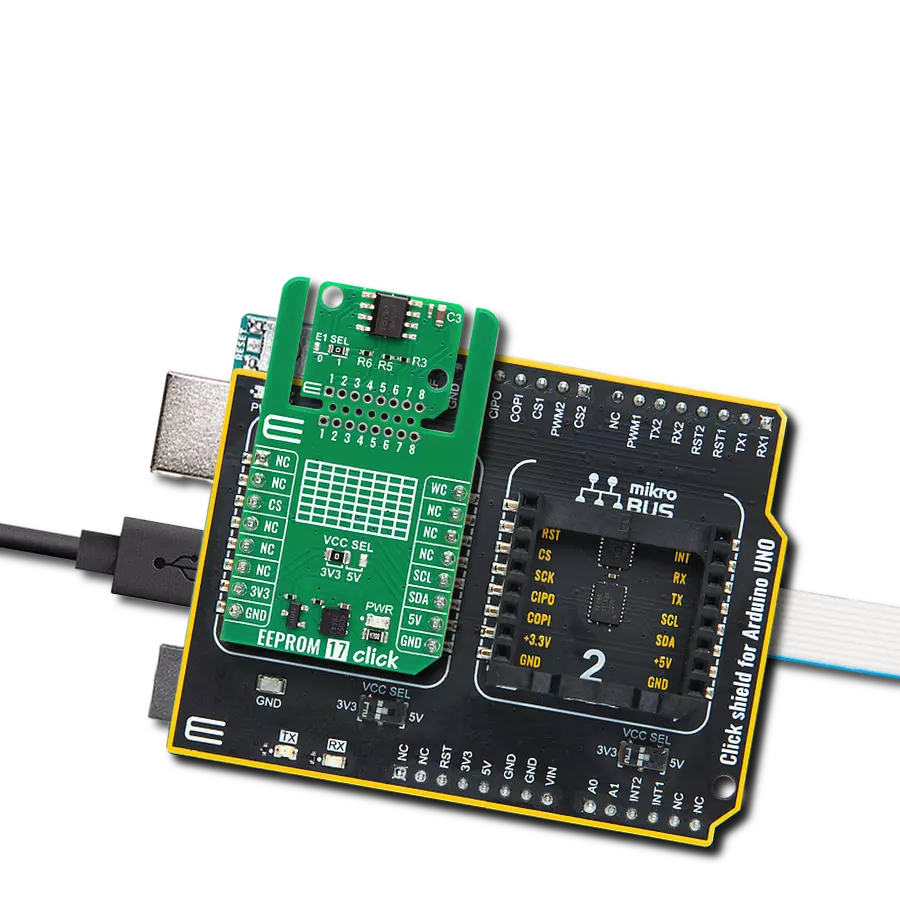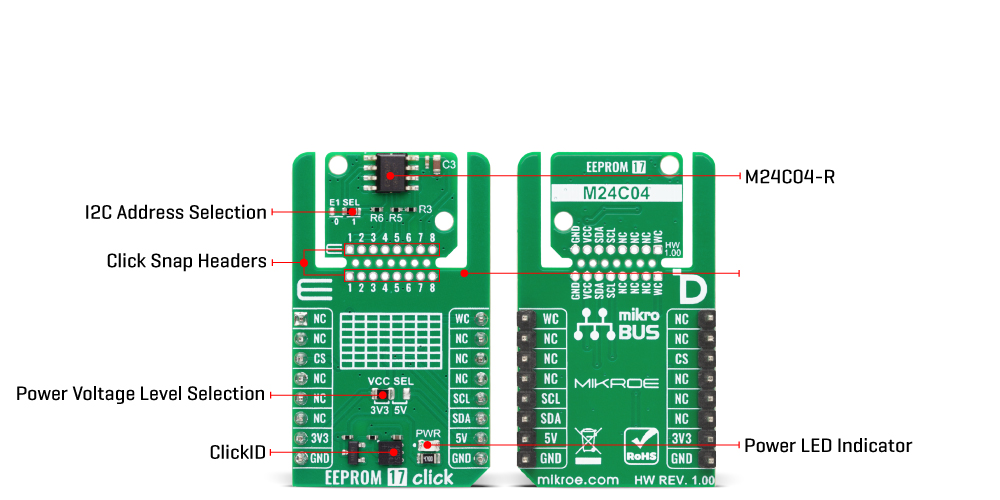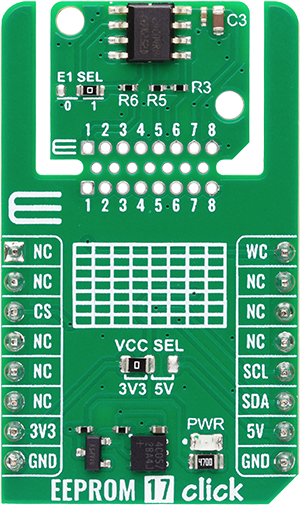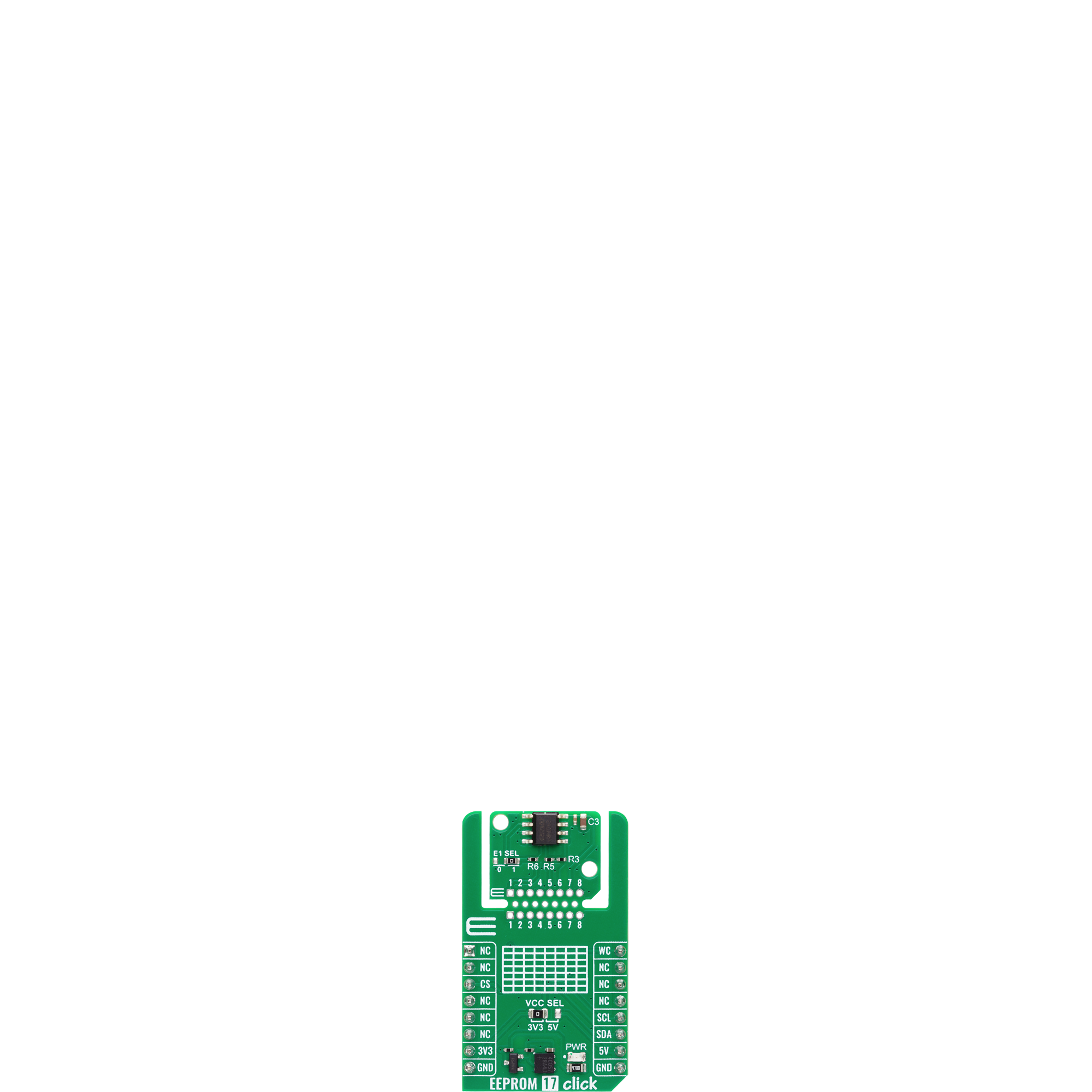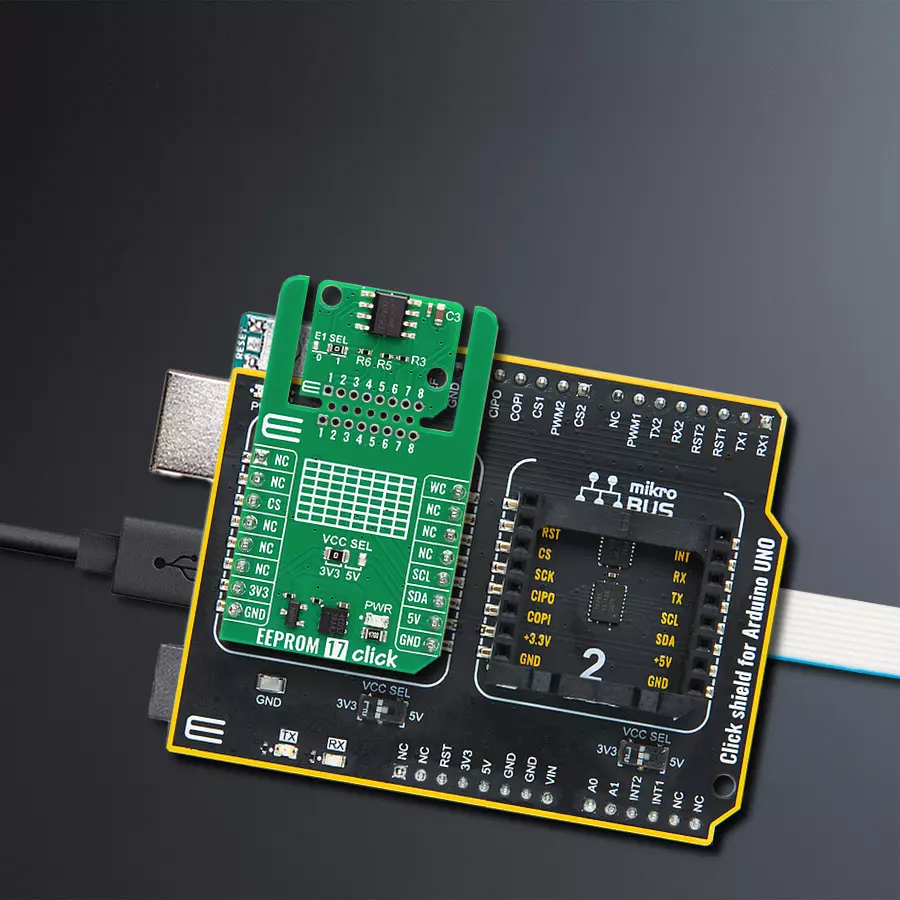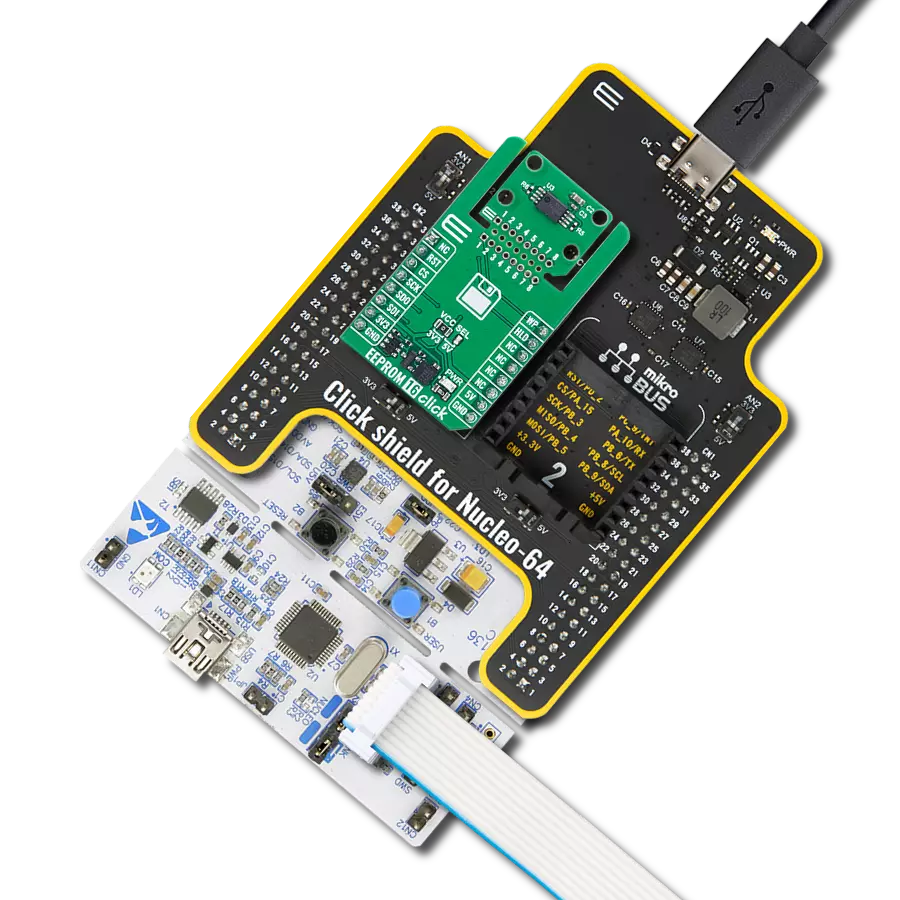Non-volatile data storage with fast I2C access and write protection feature for critical embedded applications
A
A
Hardware Overview
How does it work?
EEPROM 17 Click is based on the M24C04-R, a 4Kbit serial I2C bus EEPROM from STMicroelectronics, organized as 512 bytes with a page size of 16 bytes. This board provides a reliable and flexible non-volatile data storage solution ideally suited for a wide range of embedded applications. It supports both random and sequential read operations, enabling efficient data access patterns for various use cases, from simple data logging to configuration storage. The write functionality includes byte and page write modes, both capable of completing a write cycle in under 5 milliseconds, which ensures fast memory updates while maintaining system responsiveness. The entire memory array can be write-protected to safeguard critical data against unintended modifications. The M24C04-R offers exceptional endurance with more than 4 million guaranteed write cycles per memory cell and ensures long-term
data integrity with a data retention period exceeding 200 years. This Click board™ is designed in a unique format supporting the newly introduced MIKROE feature called "Click Snap." Unlike the standardized version of Click boards, this feature allows the main sensor/IC/module area to become movable by breaking the PCB, opening up many new possibilities for implementation. Thanks to the Snap feature, the M24C04-R can operate autonomously by accessing its signals directly on the pins marked 1-8. Additionally, the Snap part includes a specified and fixed screw hole position, enabling users to secure the Snap board in their desired location. This Click board™ uses an I2C interface with clock speeds of up to 400kHz, ensuring fast communication with the host MCU. The I2C address of the M24C04-R can be easily configured via onboard jumper marked E1 SEL in the Snap area, allowing multiple devices to coexist
on the same bus. Beyond communication pins, this board is also equipped with a write control signal (WC) for protecting the entire contents of the memory from inadvertent write operations. Write operations are disabled to the entire memory array when write control (WC) is driven HIGH. When write control (WC) is driven HIGH, device select and address bytes are acknowledged; data bytes are not acknowledged. This Click board™ can operate with either 3.3V or 5V logic voltage levels selected via the VCC SEL jumper. This way, both 3.3V and 5V capable MCUs can use the communication lines properly. Also, this Click board™ comes equipped with a library containing easy-to-use functions and an example code that can be used as a reference for further development.
Features overview
Development board
Arduino UNO is a versatile microcontroller board built around the ATmega328P chip. It offers extensive connectivity options for various projects, featuring 14 digital input/output pins, six of which are PWM-capable, along with six analog inputs. Its core components include a 16MHz ceramic resonator, a USB connection, a power jack, an
ICSP header, and a reset button, providing everything necessary to power and program the board. The Uno is ready to go, whether connected to a computer via USB or powered by an AC-to-DC adapter or battery. As the first USB Arduino board, it serves as the benchmark for the Arduino platform, with "Uno" symbolizing its status as the
first in a series. This name choice, meaning "one" in Italian, commemorates the launch of Arduino Software (IDE) 1.0. Initially introduced alongside version 1.0 of the Arduino Software (IDE), the Uno has since become the foundational model for subsequent Arduino releases, embodying the platform's evolution.
Microcontroller Overview
MCU Card / MCU
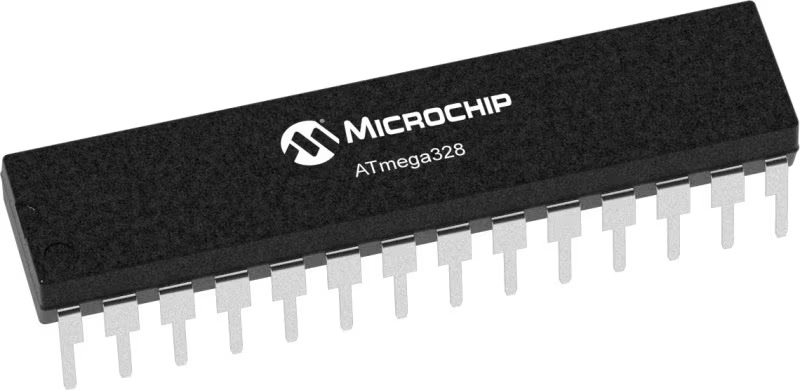
Architecture
AVR
MCU Memory (KB)
32
Silicon Vendor
Microchip
Pin count
32
RAM (Bytes)
2048
You complete me!
Accessories
Click Shield for Arduino UNO has two proprietary mikroBUS™ sockets, allowing all the Click board™ devices to be interfaced with the Arduino UNO board without effort. The Arduino Uno, a microcontroller board based on the ATmega328P, provides an affordable and flexible way for users to try out new concepts and build prototypes with the ATmega328P microcontroller from various combinations of performance, power consumption, and features. The Arduino Uno has 14 digital input/output pins (of which six can be used as PWM outputs), six analog inputs, a 16 MHz ceramic resonator (CSTCE16M0V53-R0), a USB connection, a power jack, an ICSP header, and reset button. Most of the ATmega328P microcontroller pins are brought to the IO pins on the left and right edge of the board, which are then connected to two existing mikroBUS™ sockets. This Click Shield also has several switches that perform functions such as selecting the logic levels of analog signals on mikroBUS™ sockets and selecting logic voltage levels of the mikroBUS™ sockets themselves. Besides, the user is offered the possibility of using any Click board™ with the help of existing bidirectional level-shifting voltage translators, regardless of whether the Click board™ operates at a 3.3V or 5V logic voltage level. Once you connect the Arduino UNO board with our Click Shield for Arduino UNO, you can access hundreds of Click boards™, working with 3.3V or 5V logic voltage levels.
Used MCU Pins
mikroBUS™ mapper
Take a closer look
Click board™ Schematic
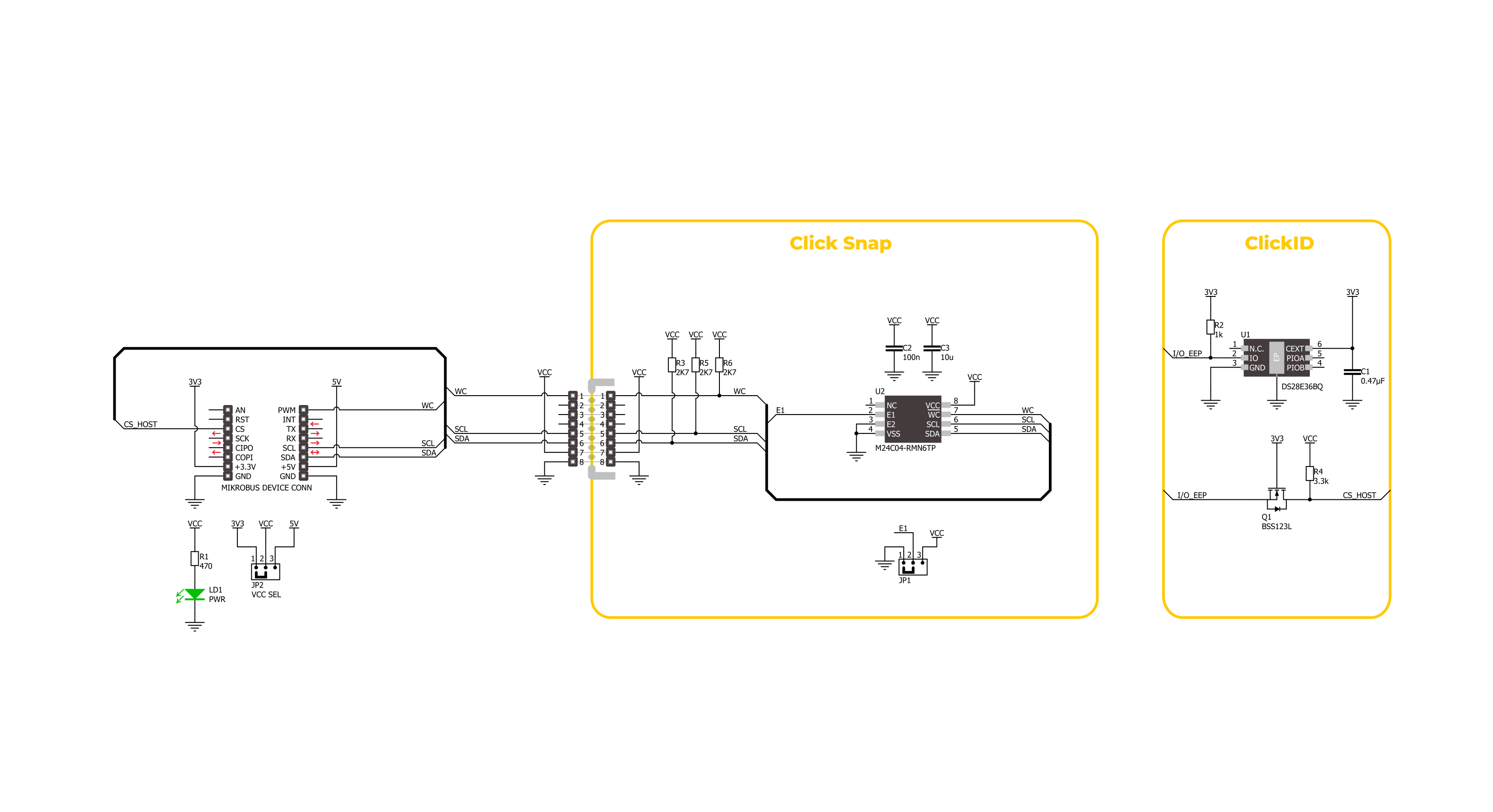
Step by step
Project assembly
Software Support
Library Description
EEPROM 17 Click demo application is developed using the NECTO Studio, ensuring compatibility with mikroSDK's open-source libraries and tools. Designed for plug-and-play implementation and testing, the demo is fully compatible with all development, starter, and mikromedia boards featuring a mikroBUS™ socket.
Example Description
This example demonstrates the use of EEPROM 17 Click board by writing specified data to the memory and reading it back.
Key functions:
eeprom17_cfg_setup- This function initializes Click configuration structure to initial values.eeprom17_init- This function initializes all necessary pins and peripherals used for this Click board.eeprom17_write_memory- This function writes data to the EEPROM memory starting from the specified address.eeprom17_read_memory- This function reads data from the EEPROM memory starting from the specified address.eeprom17_select_bank- This function selects the active memory bank in the EEPROM.
Application Init
Initializes the driver and logger.
Application Task
Writes a desired number of bytes to the memory and then verifies if it is written correctly by reading from the same memory location and displaying the memory content on the USB UART.
Open Source
Code example
The complete application code and a ready-to-use project are available through the NECTO Studio Package Manager for direct installation in the NECTO Studio. The application code can also be found on the MIKROE GitHub account.
/*!
* @file main.c
* @brief EEPROM 17 Click example
*
* # Description
* This example demonstrates the use of EEPROM 17 Click board by writing specified data to
* the memory and reading it back.
*
* The demo application is composed of two sections :
*
* ## Application Init
* Initializes the driver and logger.
*
* ## Application Task
* Writes a desired number of bytes to the memory and then verifies if it is written correctly
* by reading from the same memory location and displaying the memory content on the USB UART.
*
* @author Stefan Filipovic
*
*/
#include "board.h"
#include "log.h"
#include "eeprom17.h"
#define DEMO_TEXT_MESSAGE_1 "MIKROE"
#define DEMO_TEXT_MESSAGE_2 "EEPROM 17 Click"
#define STARTING_ADDRESS 0x10
static eeprom17_t eeprom17;
static log_t logger;
void application_init ( void )
{
log_cfg_t log_cfg; /**< Logger config object. */
eeprom17_cfg_t eeprom17_cfg; /**< Click config object. */
/**
* Logger initialization.
* Default baud rate: 115200
* Default log level: LOG_LEVEL_DEBUG
* @note If USB_UART_RX and USB_UART_TX
* are defined as HAL_PIN_NC, you will
* need to define them manually for log to work.
* See @b LOG_MAP_USB_UART macro definition for detailed explanation.
*/
LOG_MAP_USB_UART( log_cfg );
log_init( &logger, &log_cfg );
log_info( &logger, " Application Init " );
// Click initialization.
eeprom17_cfg_setup( &eeprom17_cfg );
EEPROM17_MAP_MIKROBUS( eeprom17_cfg, MIKROBUS_1 );
if ( I2C_MASTER_ERROR == eeprom17_init( &eeprom17, &eeprom17_cfg ) )
{
log_error( &logger, " Communication init." );
for ( ; ; );
}
log_info( &logger, " Application Task " );
}
void application_task ( void )
{
static uint8_t bank_sel = EEPROM17_BANK_SEL_0;
uint8_t data_buf[ EEPROM17_MEM_PAGE_SIZE + 1 ] = { 0 };
// Selecting memory bank
eeprom17_select_bank ( &eeprom17, bank_sel );
log_printf ( &logger, "\r\n Memory bank: %u\r\n", ( uint16_t ) bank_sel );
log_printf ( &logger, " Memory address: 0x%.2X\r\n", ( uint16_t ) STARTING_ADDRESS );
bank_sel ^= EEPROM17_BANK_SEL_1;
// Write/Read first iterration
if ( strlen ( DEMO_TEXT_MESSAGE_1 ) > EEPROM17_MEM_PAGE_SIZE )
{
memcpy ( data_buf, DEMO_TEXT_MESSAGE_1, EEPROM17_MEM_PAGE_SIZE );
}
else
{
memcpy ( data_buf, DEMO_TEXT_MESSAGE_1, strlen ( DEMO_TEXT_MESSAGE_1 ) );
}
if ( EEPROM17_OK == eeprom17_write_memory ( &eeprom17, STARTING_ADDRESS, data_buf, EEPROM17_MEM_PAGE_SIZE ) )
{
log_printf ( &logger, " Write data: %s\r\n", data_buf );
}
Delay_ms ( 100 );
memset ( data_buf, 0, sizeof ( data_buf ) );
if ( EEPROM17_OK == eeprom17_read_memory ( &eeprom17, STARTING_ADDRESS, data_buf, EEPROM17_MEM_PAGE_SIZE ) )
{
log_printf ( &logger, " Read data: %s\r\n", data_buf );
}
Delay_ms ( 100 );
// Write/Read second iterration
if ( strlen ( DEMO_TEXT_MESSAGE_2 ) > EEPROM17_MEM_PAGE_SIZE )
{
memcpy ( data_buf, DEMO_TEXT_MESSAGE_2, EEPROM17_MEM_PAGE_SIZE );
}
else
{
memcpy ( data_buf, DEMO_TEXT_MESSAGE_2, strlen ( DEMO_TEXT_MESSAGE_2 ) );
}
if ( EEPROM17_OK == eeprom17_write_memory ( &eeprom17, STARTING_ADDRESS, data_buf, EEPROM17_MEM_PAGE_SIZE ) )
{
log_printf ( &logger, " Write data: %s\r\n", data_buf );
}
Delay_ms ( 100 );
memset ( data_buf, 0, sizeof ( data_buf ) );
if ( EEPROM17_OK == eeprom17_read_memory ( &eeprom17, STARTING_ADDRESS, data_buf, EEPROM17_MEM_PAGE_SIZE ) )
{
log_printf ( &logger, " Read data: %s\r\n", data_buf );
}
Delay_ms ( 1000 );
Delay_ms ( 1000 );
}
int main ( void )
{
/* Do not remove this line or clock might not be set correctly. */
#ifdef PREINIT_SUPPORTED
preinit();
#endif
application_init( );
for ( ; ; )
{
application_task( );
}
return 0;
}
// ------------------------------------------------------------------------ END
Additional Support
Resources
Category:EEPROM
